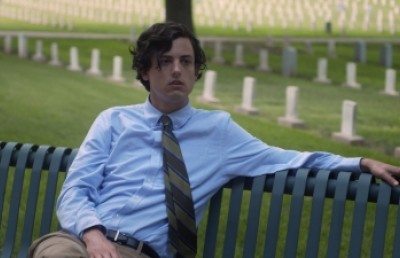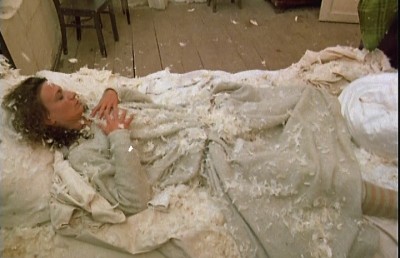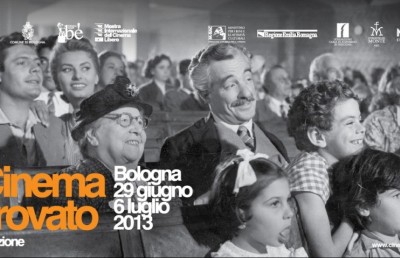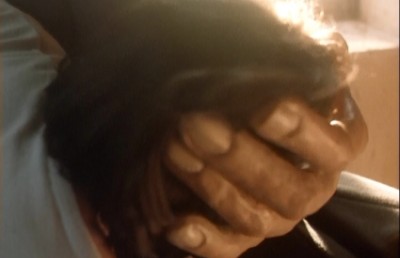RIP: Vadim Yusov, Tarkovsky and the Cinematographer
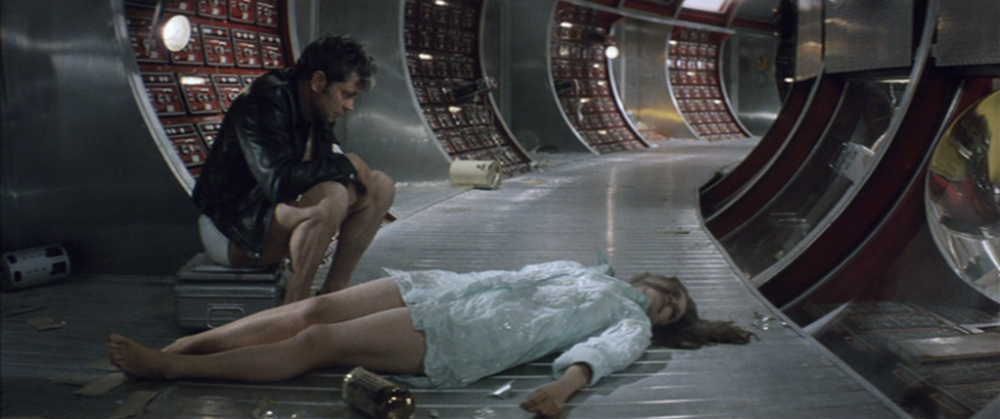
One of the great Soviet artists, cinematographer Vadim Yusov died on August 23, 2013 at the age of 84. Yusov had worked with Andrei Tarkovsky on his first four films, including his diploma film Steamroller and the Violin (1959), and his first three features, all masterpieces, Ivan’s Childhood (1962), Andrei Rublev (1966), and Solaris (1972). Creative differences saw him break his working relationship with Tarkovsky for his next film, Mirror (1975) –after reading a version of the script he thought the film was too autobiographical. Not many cinematographers can claim to have filmed in sequence (starting with Ivan’s Childhood) three such startlingly beautiful and magically inventive pieces of cinema. I have seen these films in total well over a dozen times and each new viewing reveals new bits of mystery and poetry.
Alongside his four films with Tarkovsky Yusov is best known for his works with Tarkovsky’s contemporary (and from all accounts, nemesis), Sergei Bondarchuk. As Sean Martin notes in his pocket book essential guide on Tarkovsky, Tarkovsky was all set to win the Palme D’or at the 1983 Cannes Film Festival, but the official Russian delegate, led by Bondarchuk, convinced the jury to instead award Tarkovsky a lesser prize, the Grand Prix de Création, which he shared with Robert Bresson’s L’Argent (Martin, p. 169) Tarkovsky of course had also cast, to great effect, Sergei’s 20-year old daughter Natalya Bondarhcuk as Hari in the last film Yusov would shoot for Tarkovsky, Solaris. Yusov was the cinematographer on four of Bondarchuk’s films: Boris Godonov (1986), They Fought For Their Country (1975), Red Bells Part 1: Mexico on Fire (1982) and Red Bells Part 2: I Saw the Birth of a New World (1983). Yusov also worked three times with director Ivan Dykhovichnyy, on The Black Monk (1988), Prorva (1992), and The Kopeck (2002); and four times with director Georgiy Daneliya, on Walking the Streets of Moscow (1964), Pasport (1971), and The Adventures of Huckleberry Finn (1974).
Andrei Rublev has an epic grandeur and emotional scope which manages to bridge the mechanics of the sprawling historical epic (which never really interested Tarkovsky) with the intimate details of personal tragedy, in the latter case Rublev’s rude awakening to the horror and misery of the world outside the cloistered life of a monastery. Tarkovsky and Yusov would repeat this blend of large scale genre trappings with small scale human drama/angst in the science-fiction Solaris. Through the horrors that Rublev witnesses, and indeed enacts (he kills a man to save a simple peasant woman), he takes a vow of silence (foreshadowing Alexandre’s similar vow of silence in The Sacrifice), renounces his calling (painting) but through witnessing, like a silent observer, the joyous creation of a church bell orchestrated by a nervous, frantic young boy– its creation itself a curious mix of stubborn determinism, sheer luck, and maybe a touch of divine intervention– Rublev regains his ‘voice’ and calling. The over three hour journey (in the long version) of what is essentially paradise lost and paradise regained, ends up being one of the greatest film accounts on the power of art to redeem humanity. One could see an organic development of the long take/camera movement aesthetic from Ivan Childhood To Andrei Rublev, a style for which I’ve come up with a specific term which joins together camera movement and intricate, nuanced mise en scene, ‘camera choreography’.
Where most directors sacrifice subtlety of mise en scene for the energy and kineticism of camera movement (a pattern exacerbated by the invention of the steadicam in the late 1970s), Tarkovsky (and Yusov) always kept the camera movement at the service of the dynamics happening within the frame, the character blocking, lighting, movement, and passage of time. The ‘rise and fall’ or vertical/horizontal movements that open Ivan’s Childhood in Ivan’s dream of flight, becomes the more elaborate manned balloon flight prologue in Andrei Rublev. Rublev is full of sweeping camera movements across large natural spaces and in and out of interior locations, achieved right from the opening manned flight balloon prologue which tracks in and out of the castle and takes us skyward with the balloonist, as he experiences both the giddy heights of flight and the Icarus-like fall to earth. In both openings, one a dream one a ‘realistic’ fantasy, the vertical rise and fall of the camera serves to demonstrate humanity’s attachment to, both literally and figuratively, EARTH; and to how humanity must ultimately remain ‘grounded’ in the face of adversity. The same theme is played out writ large in Solaris, where astronauts living on a space station orbiting the planet Solaris, experience powerful pangs of homesickness and a longing for earth.
In honor of Yusov’s work with Tarkovsky I would like to discuss just a few moments which capture, in their essence, the value of Yusov’s contribution to Tarkovsky films. The first element is the photographing of an apple, partly because as a fruit which grows from a tree, which grows in the ground, it symbolizes the importance of nature in the aesthetic world of Tarkovsky (click here for my essay on this aspect of Tarkovsky’s style). An apple appears in both of the first two films that Yusov worked on, The Steamroller and the Violin and Ivan’s Childhood (and if memory serves me well, apples are also briefly seen in Andrei Rublev). The apple appears in the scene where the young boy Sasha goes to his violin lesson. Sasha and another little girl wait patiently seated outside the teacher’s study. Sasha and the girl make frequent eye contact, the girl made aware of an apple that Sasha takes from his pocket and cleans on his sweater, in anticipation of eating it. When a pupil leaves the teacher’s study it is Sasha’s turn.
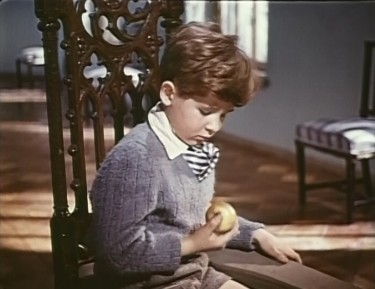
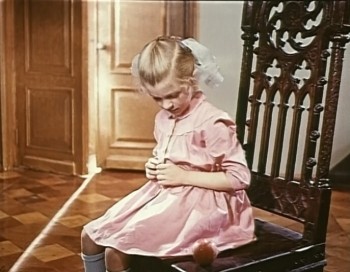
As he enters the room the camera frames his apple left behind on his seat in the foreground with the girl behind it. The framing of the apple in the foreground, the girl in the middle ground and the door slightly ajar in the background, with a streak of light visible, renders the tiny drama of the moment: will the girl be tempted by the apple (a Biblical reference?). The girl gives a few covetous glances at the apple. To curb her temptation she even picks the apple up and places it farther away from her onto another chair. As Sasha’s off-screen playing is heard, the camera dollies in to a tight close-up of the apple, throwing all else out of focus.
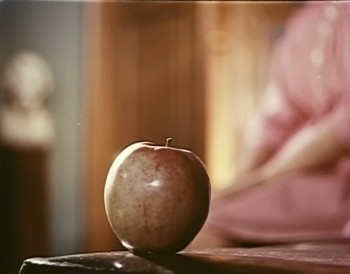
The scene then cuts to Sasha’s lesson, which lasts over two and a half minutes. For the time being, we forget about the apple. As Sasha exits the room, dejected after being reprimanded by his teacher for his ‘undisciplined’ playing (“What should I do with you? Too much imagination.”), he too forgets about his apple. But again the camera dollies in to the scene closing shot, a close-up of the now eaten (by the little girl we can only assume) apple.
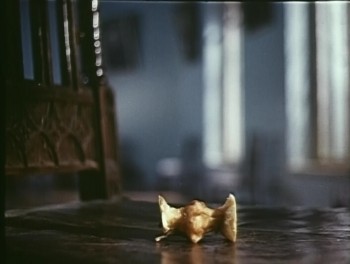
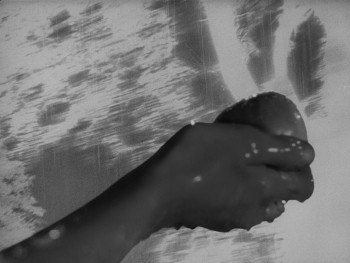
Apples in dream scene from Ivan’s Childhood
Although the scene is ‘about’ Sasha’s music lesson, and the behaviour of the stern music teacher, who reprimands Sasha for being “too creative” can be seen perhaps as a veiled criticism of Socialist Realism, the official Soviet art, Tarkovsky makes the apple the centerpiece. While the apple appears in a realistic setting in Steamroller, albeit with a hint of fairy tale (and perhaps the noted Biblical reference to the Garden of Eden), it re-appears in Ivan’s Childhood in one of the four dream settings Tarkovsky added to the script when he was hired to take over from first director, Eduard Abalov. In comparison, the scene reverts to black and white but is far more stylized, with the use of slow motion, negative rear projection which gives the illusion of the scene spinning as if on a carousel and the girl magically leaving frame left only to re-appear frame right. And yet the scene has the same basic ingredients as the music lesson scene: a girl, a boy, and an apple. This scene can in fact be seen as a response to the scene from Steamroller, with the boy now offering the apple to the girl; the tight framing on the back of the cart cuts to a longer shot of the boy and girl seated amongst a mountain of apples, with dozens of apples falling off the loaded wagon onto the beach floor. Like the end of the Steamroller scene, the camera dollies in closer to the apples, which are also being eaten, here by horses.
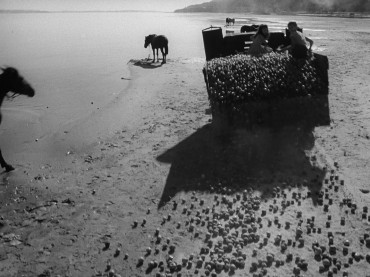
A second scene that I would like to discuss is one whose genius of execution is so impressive that I will forever be in awe of Yusov’s and Tarkovsky’s collective talents. It is a scene whose perceptual sleight of hand had eluded my awareness, until it was brought to my attention by Robert Bird in his book Andrei Tarkovsky: Elements of Cinema. The scene from Andrei Rublev is Rublev’s fantasy of Christ’s crucifixion or as the scene is sometimes referred to, “The Passion According to Andrei,” or as Bird calls it, the “passion play.” I had seen Andrei Rublev at least five times before Robert Bird told me what to look for: “…This cloth is revealed to be the first shot of a new scene consisting of a Passion play, set in wintry Russia, accompanied by a drum and choral music, and featuring winged angels. Iusov has explained in general terms that the invisibility of the angels was ensured by the close coordination of dark and light elements in the frame, the careful selection of film and the use of optics that heighten the perspective on screen” (R. Bird, p. 82). That I had seen this scene so many times and never seen the angels, “hiding in plain sight,” is also a great testament to the collaborative nature of film; nearly every aspect of film production worked together to make the angels ‘present’ but barely perceptible: cinematography (lighting, framing, composition), camera operator/grip (camera movement), costume, art direction, acting, and of course direction. In the back of my mind I had always wondered why this scene was lit so brightly, overexposed, lacking overall contrast, and filmed against a snow-filled landscape. Now I had my answer. Whenever I have the opportunity to teach Andrei Rublev, even those students reared on Hollywood who have no patience for Tarkovsky admit marvel when I relay this cinema sleight of hand. Below I will place one frame grab which contains one of the angel moments. There are several other such ‘appearances,’ but I’ll leave you the joy of discovering them for yourself.
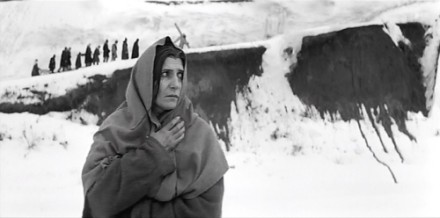
Yusov and Tarkovsky’s ‘angels’
Tarkovsky continued to work with great cinematographers. After his falling out with Yusov Tarkovsky hired Georgi Ivanovich Rerberg, five years his junior, to work on Mirror (1975), arguably Tarkovsky’s greatest film (in my own mind, this title goes to either Mirror, Andrei Rublev or Stalker, depending on my mood and state of mind). Rerberg’s work is different from Yusov’s, less tied to an over-arching structure and more varied in its tone and lighting. Unfortunately, their relationship would short circuit as well, with Rerberg continuing on Tarkovsky’s next film Stalker but being fired and replaced by Aleksandr Knyazhinsky after the ill-fated, aborted first take of Stalker. Being fired by Tarkovsky, and in some circles blamed for the debacle of the first version’s demise, stunted Rerberg’s career, which never recovered. Of course there are always two sides to a story, and Rerberg’s own version of this (and his career in general) is given voice in the excellent documentary by Igor Maiboroda: Rerberg and Tarkovsky: The Reverse Side of Stalker (Rerberg i Tarkovskii: Obratnaia storona Stalkera, 2009). For a fuller account of the history behind the first version of Stalker, read this review of the documentary by Tarkovsky scholar Robert Bird, here.
After Stalker Tarkovsky co-directed with Tonino Guerra the documentary around the pre-production of the film Tarkovsky would soon shoot in exile in Italy, Nostalghia, Voyage in Time. The film was photographed by another great Italian cinematographer Luciano Tavoli, whose other film credits include Argento’s Suspiria (1977, one of the most outstandingly photographed horror films ever) and Tenebre (1982); two films for Michelangelo Antonioni, The Passenger (1975) and The Mystery of Oberwald (1982); and Julie Taymor’s experimental adaptation of Titus Andronicus, Titus (1999). Nostalghia was lensed by Italian Guiseppe Lanci (Offscreen interview here). Tarkovsky’s final film was shot by another master, Ingmar Bergman’s frequent collaborator, Sven Nykvist.
Yusov was only three years Tarkovsky’ senior. His death brings to mind the fact that Tarkovsky would be 81 years old today had he not succumbed to cancer in 1986. What kind of films would Tarkovsky have added to his filmography? Would Yusov, a man who routinely worked with the same few directors, buried his creative differences to work with Tarkovsky once again? We can only wonder.

First shot of The Steamroller and the Violin

Last shot of Solaris The first and last recorded shots of the Yusov-Tarkovsky collaboration
Bibliography
Bird, Robert. Andrei Tarkovsky: Elements of Cinema. London: Reaktion Book, 2008.
Martin, Sean. Andrei Tarkovsky. Pocket Essentials, Trafalgar Square Publishing, 2005.
For an interesting account of the history of Russian films at Cannes, read Joel Chapron’s essay here



